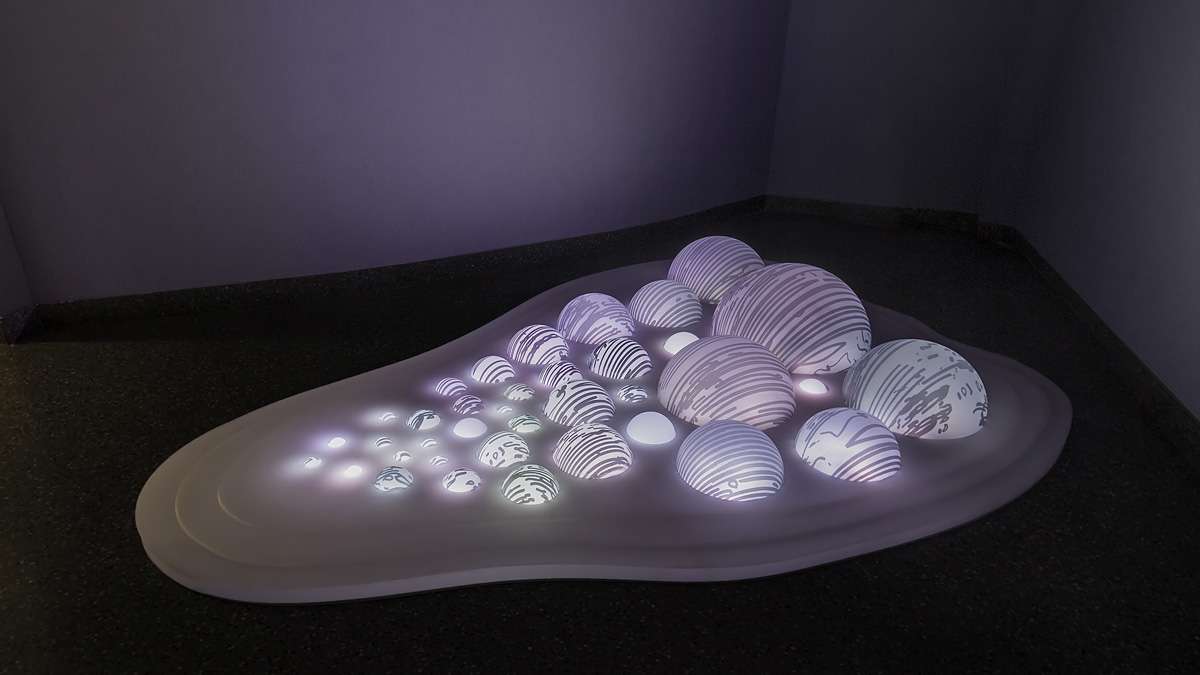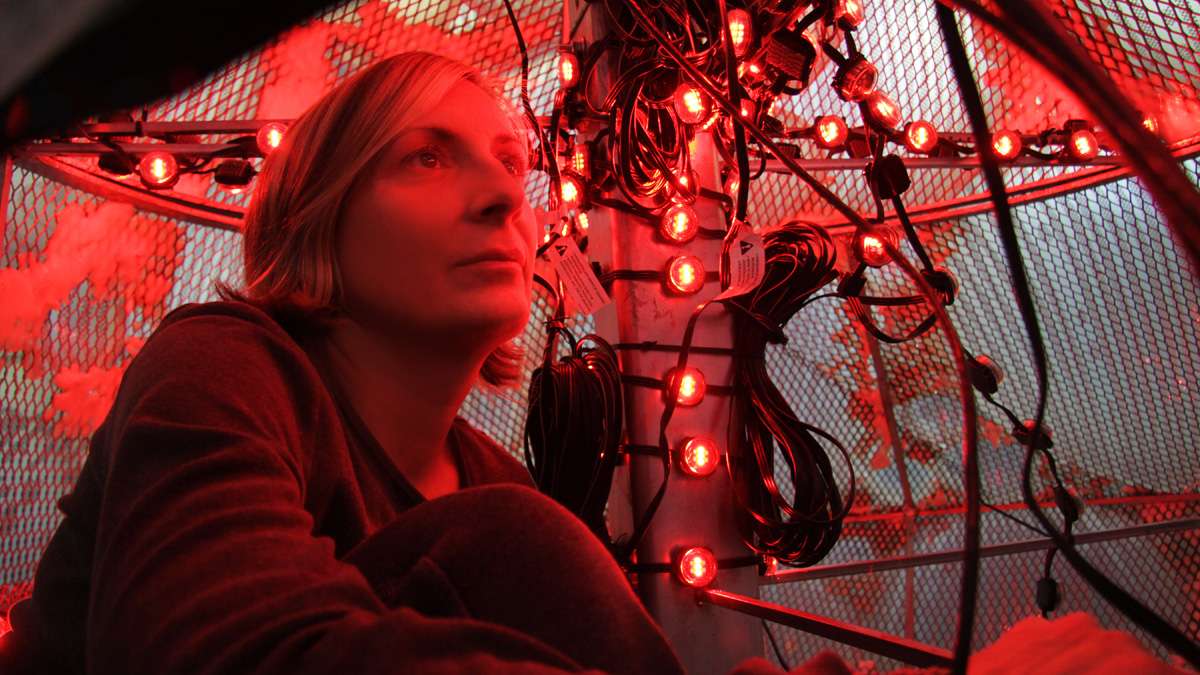Futuristic looking light bubbles part of new exhibit at Rutgers New Brunswick [photos]
-

City Councilman Mark Squilla listens to testimony before the Committee on Education. (Emma Lee/WHYY)
-

Education activists Allison McDowell (left) and Diane Payne attend hearings at City Council to express their objections to standardized testing. (Emma Lee/WHYY)
-

State Rep. Mike Tobash testifies before the Philadelphia City Council Committee on Education during an inquiry into the costs and results of standardized testing. (Emma Lee/WHYY)
-

Jannie Blackwell, chair of Education Committee of Philadelphia City Council, listens to testimony on the value of stadardized testing. (Emma Lee/WHYY)
-

Councilman Mark Squilla listens to testimony about the costs and effects of standardized testing in Philadelphia schools. (Emma Lee/WHYY)
-

-

-

-

As you enter the Mary H. Dana Women Artists Series Galleries at Rutgers’ Douglass Library in New Brunswick, there is a large pulsating vinyl form, and sculptural islands of shimmering white bubbles rise upward. This futuristic form changes color, undulating like a form of life we haven’t yet met. Though trance-inducing, it is a complicated work of technology with LED lighting programmed into patterns and sequences, and video animation illuminating the gallery space around it.
“Light Between the Islands #2” by Grimanesa Amoros, on view through December 10, is part of Momentum: Women/Art/Technology, a series of exhibitions presenting innovative uses of technology by women and transgender artists. Momentum includes an online festival of video works and a directory of women and transgender artists who embrace technologies. An online catalog is forthcoming.
“There is a huge movement in the transgender community for this kind of scholarship and artistic pursuit, at the same time the definition of what it means to be a woman is expanding,” said IWA Director Connie Tell.
Amoros is known for large-scale light-based public art installations exhibited worldwide. Not only do the sculptures incorporate video, lighting and computer programming, but they respond to and engage architecture. Her site-specific installation, “Breathless Maiden Lane,” a composition of moving light, is on view at 125 Maiden Lane in the Financial District of New York through January 9, 2015, as part of the Time Equities Art-in-Buildings program.
Amoros began making art at age 11. “Light Between the Islands,” according to her statement, suggests her beloved Uros Islands in Lake Titicaca in the Andes. A native of Peru, Amoros came to the U.S. in 1984 at age 20 to study at the Art Students League. She left University of Lima three credits shy of a bachelor’s degree in psychology.
At the Art Students League, Amoros worked from 8 a.m. to 10 p.m., supplementing her education with independent reading and visiting museums. “It was a Bohemian life, but I have no regrets – I love what I’m doing. When you are passionate about something, even in business, it seems effortless and you don’t count the time. If you set goals with a time frame you suffer, but if you follow your dreams it will come.”
As a young woman, Amoros recollects, she wanted to be like Mother Theresa, but a friend pointed out she likes shoes and wine too much to give them up. Her earlier work included painting, encaustic, drawing and photography. In 2000, during a trip to Iceland and seeing the Aurora Borealis, “I couldn’t stop saying ‘wow,'” Amoros recounted from her New York studio. “I want to share it with others. I don’t want to just stay in my studio.”
She realized that she could fulfill this dream with appropriate technology. “I’m the kind of person that, when I like something, I start doing it,” she says. “In 2000 I realized I wanted to work with lights, but at that time the cost of using LEDs was prohibitive, so I started with theater lighting. I was fascinated by the lighting of Broadway. But theater lights give off so much heat, and you have to change the gels every few months, so in 2005 I switched to LEDs.”
Amoros taught herself about the electrical hardware and the programming she needed to do the sequencing. Her “Terrarium” light installation in TriBeCa is featured on the Philips lighting website for its transitions from one color to another using Color Kinetics, iPlayer 2, ColorPlay, DMX control and iColor Flex SLX strands.
Depending on the project, Amoros has anywhere from four to 10 people working for her, from helping her keep her schedule to installing and photo documenting the projects. “It’s a team effort, and quality is very important to me.” She does the technical work herself, occasionally relying on lighting consultants.
Some consider themselves good in the STEM fields (science, technology, engineering and math) and some favor the part of the brain that makes them strong in arts, language and understanding human relations. Is it the rare brain that excels in both?
“Everyone comes into the world with these goodies, but it changes when we encounter societal expectations,” says Amoros. “We all have these capabilities and talents, and its up to us to recognize and use them.” She compares the human brain to an automobile. “You have to maintain it, push the boundaries and be aware. Not everything comes from the sky, without effort — you have to put yourself out. My mother told me if you want God to work for you, you have to demonstrate that you are ready.”
Amoros compares the creation of her light installations to composing music. “Lines (of light) are my instrument,” she says. “Each one is different.”
It all begins with drawing, Amoros says. “Before you know how many lines of light, before you can be creative or work in computer assisted design, you have to start with a drawing. Just like with music, you have to compose and balance the piece.”
Amoros’s exhibition includes “Miranda,” a video that mixes imagery of circuit boards, ancient Incan monuments, Incan sun masks and animation of the artist’s face transformed by the lines of reeds, with a soundtrack by Israeli composer and musician Ivri Lider; videos documenting the installation of her works; and photographs of installations in Times Square, N.Y., Turku, Finland, Beijing and Madrid. “Once the installation comes down, the work ceases to exist, so video documentation of the projects is important to keep the artwork alive,” says Amoros.
Bringing an artist like Amoros to campus is far more effective than handing out a list of women who have made it in STEM fields, says Tell. “We know art has an important role in moving culture forward, and women are at the forefront of this movement. Grimanesa is a woman who has achieved tremendous success in a world dominated by men and is an inspiration across disciplines. We are changing STEM to STEAM, where the ‘a’ stands for artists.”
Grimanesa Amoros continues through December 10 at the Women Artists Series Galleries, Douglass Library, New Brunswick, and Momentum: Women/Art/Technology will resume January 20 through April 17, with an artists’ reception March 26. iwa.rutgers.edu
______________________________________________
The Artful Blogger is written by Ilene Dube and offers a look inside the art world of the greater Princeton area. Ilene Dube is an award-winning arts writer and editor, as well as an artist, curator and activist for the arts.
WHYY is your source for fact-based, in-depth journalism and information. As a nonprofit organization, we rely on financial support from readers like you. Please give today.





